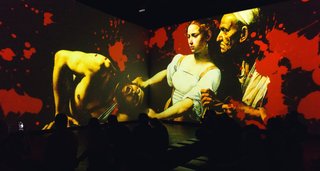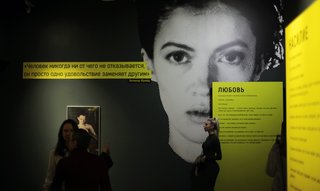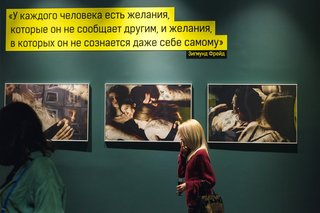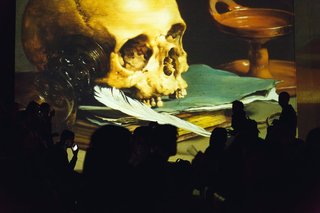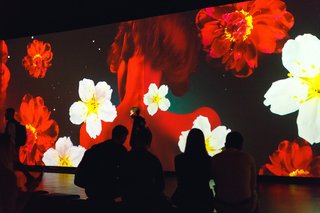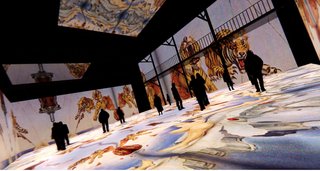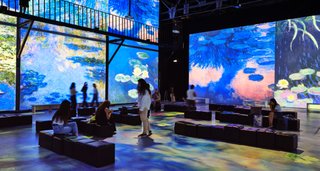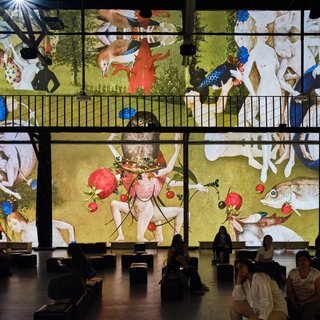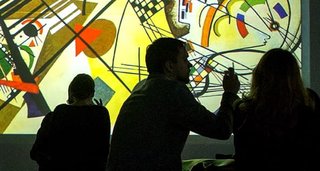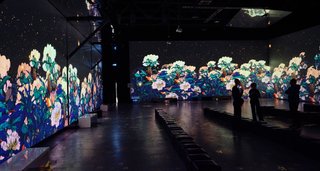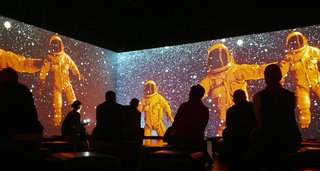Don't be a Freud | Digital Art Center Artplay Media
multimedia exhibition
Don't be
a Freud
The exhibition “Don’t be a Freud” is the first project of Artplay Media, not focused on individual artists, but on the subject of physicality and sexuality. The exhibition tells of these high feelings and weak desires inherent to each person and tells the story of violence and attraction through the prism of the human body.
The project explores the work of artists using psychoanalysis, as Sigmund Freud did in his work “The Artist and the Fantasy.” This story is consonant with everyone who falls in love and breaks up, who checks their relationship for strength and tries to find the boundaries of their sexuality.
This time, the creators of the exhibition were not content to rethink the works of old masters. Especially for the exhibition, videos were shot with the participation of the Lumpen counter-model agency, which promotes a non-classic model appearance for the industry. Those videos will be a part of the multimedia content. And in the lobby, you can see Valery Latypov's photo exhibition, reflecting the theme of physicality with the participation of the same models.
In the project “Don’t be a Freud” there was a place for modern Russian literature. In the multimedia hall, visitors can hear an off-screen voice consisting of fragments of various works by Igor Yarkevich. The text is read by the actor the “Theater of Nation” Vladimir Eremin, who voiced off Al Pacino in all his movies dubbed in Russian.
Critics about Yarkevich range from the "living classic" to the "most terrible and scandalous writer" of modern literature. In 2011, the writer became the laureate of the Nonconformism Award (labeled "for new types of prosaic thought, style and language").
The exhibition is divided into 7 new stories, each exploring the theme of physicality in its own way.
-----------------------------------------------------------------------------------------------------------------------------------
Freud about art
Despite the fact that Sigmund Freud called himself an amateur in art, he devoted a whole book to this topic - “The Artist and the Fantasy”. For Freud, a work of art is above all a manifestation of the unconscious. He wrote: “We must feel those affects of the artist, the special state of his psyche, that stimulated him to the creativity (...)Perhaps the great creations of art do not need any particular analysis? Nevertheless, the work must allow such an analysis, because it is an expression of the intentions of the artist and the emotional movements that concern us. "
Freud’s views on artist’s personality: the artist differs from an ordinary person because of his inner drives, which are suppressed by reality, therefore he, as a neurotic, turns to the world of fantasy, dreams, in order to find a substitute for unsatisfied desires there. According to Freud, an artist is a special person, a kind of seismograph of the era whose sensitivity makes him more acutely, subtly sense cultural conflicts and often leads him not only to escape into alcoholism, neurosis, but even to madness. However, according to Freud, if a neurotic moves to the unreal world of fantasies, dreams and mania, then the artist, thanks to his highly developed ability for sublimation, switches the energy of lower drives to artistic activity. Thus, according to Freud, he avoids neurosis and, moreover, helps his visitors, readers, listeners to free themselves from their internal tensions.
-----------------------------------------------------------------------------------------------------------------------------------
Unconscious genius
Are the artist’s personality and lifestyle important for understanding his work? Let's have a look at a concreate examples. Michelangelo Buonarroti did not hide his craving for young men, and his lyrics are solid platonic homoeroticism. Biographers accused Leonardo da Vinci of sexual relations with his students, and his paintings “Bacchus” and “John the Baptist”, glorifying the beauty of a young male body, leave no doubt about the sexual orientation of the artist. A little later, a lesbian plot appears - for example, the popular story of Ovid about Jupiter, who took the form of Diana to seduce the nymph Callisto, on the Rubens’s canvas.
As for Michelangelo da Caravaggio, the main part of the information about his life, researchers draw from police reports. In total, three precisely proven murders were counted behind him. In his paintings there is almost no naked female flesh, but there are a lot of beautiful half-naked young men. This fact gave rise to many versions of the real subject of his feelings and already in the twentieth century made Caravaggio a “gay icon”.
Our contemporary, artist Egon Schiele, who lived in the twentieth century, is considered a highly controversial figure in art history because of his almost pornographic drawings. At the dawn of his creative career, Schiele was arrested for seducing a minor. It was his model, his lover and the old courtesan Valerie Neusel. Schiele lived in Vienna at the time of Freudianism when, for the first time in society, people began to talk about the importance of human sexuality. The artist began to explore this subject by creating self-portraits. Previously, in the art world, nudes and self-portraits were different genres. Schiele decided to combine them.
Here is what the art historian Arkady Ippolitov writes about Schiele: “Self-portraits are the main theme of the artist’s work. There are a lot of them, all different and not like each other and often do not look like Egon Schiele himself. The self-portrait for him was not a mirror capturing an external reflection, but a means of penetrating into the most secret areas of the subconscious. Schiele- artist correlates with the Schiele- model as a psychoanalyst with a patient, painfully and scrupulously studying every line of what constitutes the elusive image of our Ego. In his studies, Schiele was frighteningly frank - very often he portrayed himself naked, staring at his thin body, and some of his self-portraits are shocking even now, as, for example, a series of "self-portraits of a masturbator."
List of artists represented at the exhibition:
Egon Schiele, Peter Paul Rubens, Michelangelo Merisi da Caravaggio, Gustav Klimt, Sandro Botticelli, Lucas Cranach, Adolf and William Burgo.
Cinema360 — this is a total multimedia installation, immersing the spectator into the sensual world of masterpieces created by great artists. The images are projected on huge screens and on the floor as well. The total area of the projection is about 1200 sq. m.
